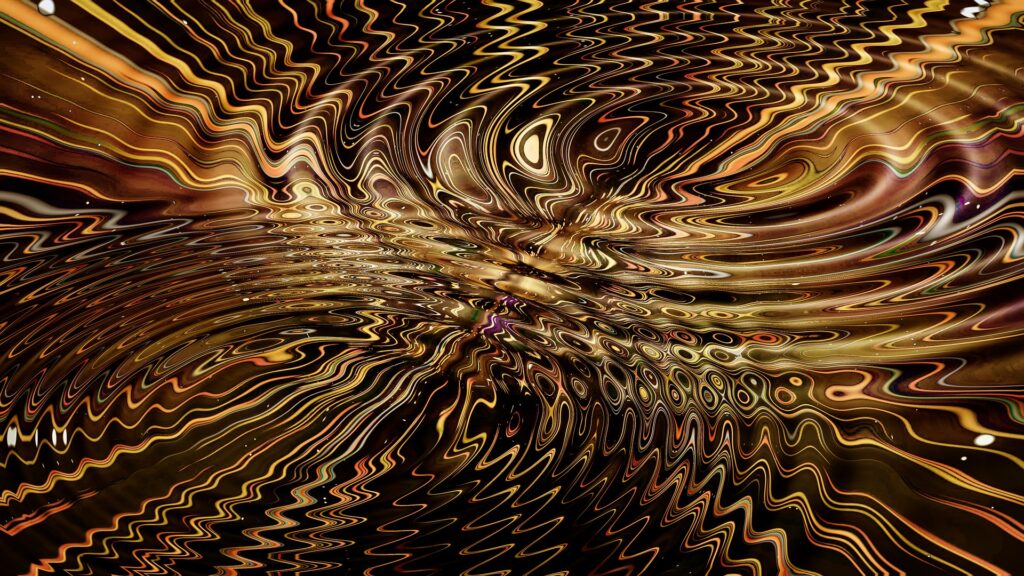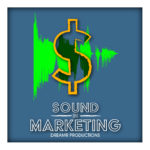How can we make something that is technically not viewable something we can connect to a tangible object or a physical product?
Sonic Branding
10 or 15 years ago, a concept like sonic branding was only available to those big brands that could afford a network TV spot. It was irrelevant to the rest of us as it was
A) Far beyond our budgets and
B) Completely useless as our only real means of advertising was by print and word of mouth.
Websites were just babies at that point. Myspace was there but….well it was Myspace, a brand new thought that no one really knew what to do with or how to actually use it effectively for anything let alone marketing.
Today you can do pretty much anything in the digital space. And that is where the birth of sonic branding really takes off.
Sound Is Visual
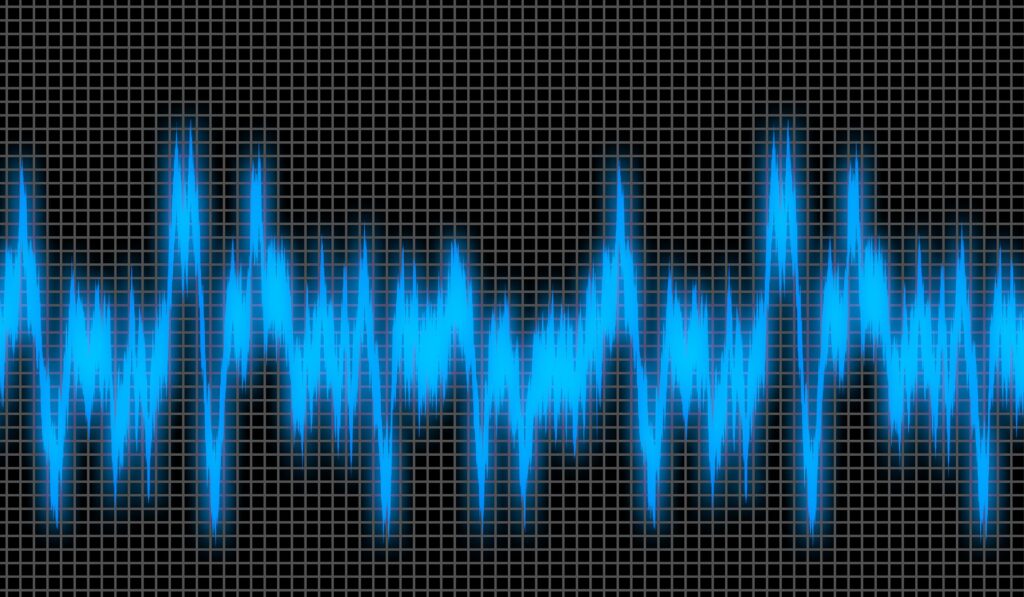
We’ve all heard, or rather seen, experiments on YouTube or TV or the like where someone poured goo on an upright speaker, turned on the speaker and cool designs and patterns resulted as the waveforms buzzed and set the goo in motion. If you haven’t seen anything like that google “cornstarch and water on a speaker”.
Sound may not seem visual at first but think about this. When you hear a sound or a song, your mind creates a visual representation. You hear a car honk, you visualize a car; maybe even a scenario of an angry motorist stuck in traffic honking at the guy in front of him. You hear a baby cry in a crowd. You may not see the baby but you’re picturing one. You hear a song from your past and it brings you back to a specific time and place.
Your brain processes sound by creating images.
Recreating that sound to become a universal image; therein lies a very difficult, and probably impossible, task. But I would wager that that is being disputed as we speak by some super smart think tank running experiments on people’s brain waves alongside sound waves. But I’m not going to go there.
So I decided to go down the rabbit hole and explore this idea of what sound looks like. I ended up finding way more information than I was expecting and a lot that I will personally go back and research more on my own. I found a term I was not familiar with, Cymatics.
Cymatics
Cymatics, is the periodic effects sound and vibration has on matter. This has been explored dating back to Da Vinci and Galileo’s observations back in the 15th and 16th centuries and theorized and evolved throughout the centuries following.
In 1680, Robert Hooke, a natural philosopher and architect among other things, noticed the vibrations of glass plates and decided to run an experiment. He covered flour on one of those glass plates and ran a bow across it to witness the patterns resulting from the vibrations of the plate onto the flour.
In the late 18th century Ernst Chaldni, a German physicist, created a sound experiment with sand. Knowing that brass was more resonant than glass, he spread fine sand on a brass plate and ran his violin bow alongside the plate. The result was that the sand created interesting designs as it “danced” to the vibrations created by the bow.
The concept and innovation of Cymatics has evolved immensely. Starting out as a cool observance of sound in visual form, it has evolved into world changing discoveries like Hans Jenny’s findings on how to help the deaf hear and even research by John Stuart Reid that the resonance of sound vibrations on granite may have influenced the development of hieroglyphic writing.
Sound In Learning
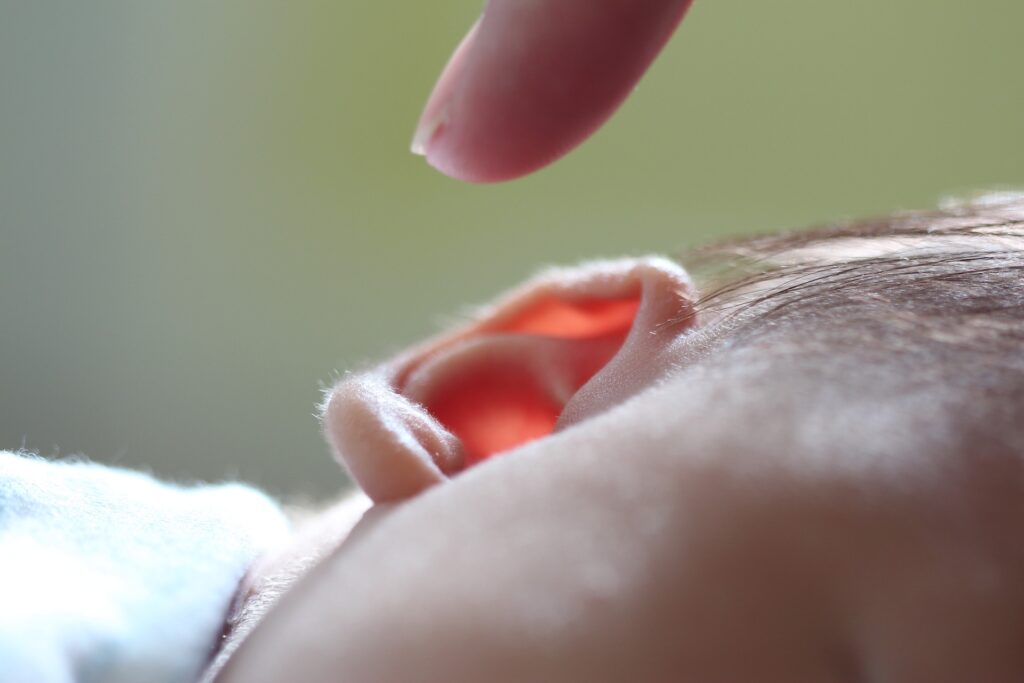
So how does this tie to us humans and eventually our marketing?
In infants, it is shown that before language is learned, first they must associate sound properties of their future native language. Sounds associated with their world guide their discovery of language. They will recognize sound patterns that are repeated frequently that engage the infant’s interest.
Sound is how a baby learns something from nothing.
Through all of my research, I wonder if by creating visual sound patterns for babies, could we help them learn language faster? By using Margarat Watts Hughes’ Eidophone concept (a device that created “voice figures” when sung into) and Hans Jennys’ Tonoscope (an electromechanical transducer that excites the membranes) could we possibly have the capacity to do this now?
It makes sense to me that by stimulating more than just one sense at a time, the process of learning could possibly be accelerated and more thoroughly ingrained into one’s psyche. Even in our marketing, if we really want to be creative, we try and activate more than one sense at a time. We know that that helps to solidify and ingrain the memory of our product into our consumer.
Sound Is More Than Music and Noise
Sound is more than just pretty music or distracting sounds. It has helped shape our history and development and continues to do so. It is the precursor to language. It is powerful. If it has this much hold on us, why shouldn’t we be incorporating it in everything about us?
Going back to the idea of using more than one sense at a time, I bring you this example. There is a sonic branding agency, Massive Music that embarked on a project called The Sound of Ithra.
The King Abdulaziz Center for World Culture, Ithra, is located in Dhahran, Saudia Arabia. It is known as an architectural marvel and, according to TIME, one of the greatest places on earth. It houses an idea lab, a library, two museums, a cinema and a knowledge center. Massive Music was hired to create the sound of the Center.
Seeing as this building is the gateway between Saudia Arabia and the world, it had to be something that represented the building, the country, and the world. That’s a big task to undertake. So the guys (and gals) at Massive took to walking the halls of the building capturing the sounds that the actual material created like the acoustics of a clap, knocking on the walls, running their hands across objects, anything that came directly from the experience of the object; i.e. the building. Then they created 23 variations of their foundational sound to work over multiple events, ethnically appropriate musical voicings and rhythms, and specific learning focuses (like a Kids Zone version).
They set out to share the experience of visiting the Ithra building with the world, by sharing it in their own unique cultural and ethnological musical and tonal languages.
Together Through Sound
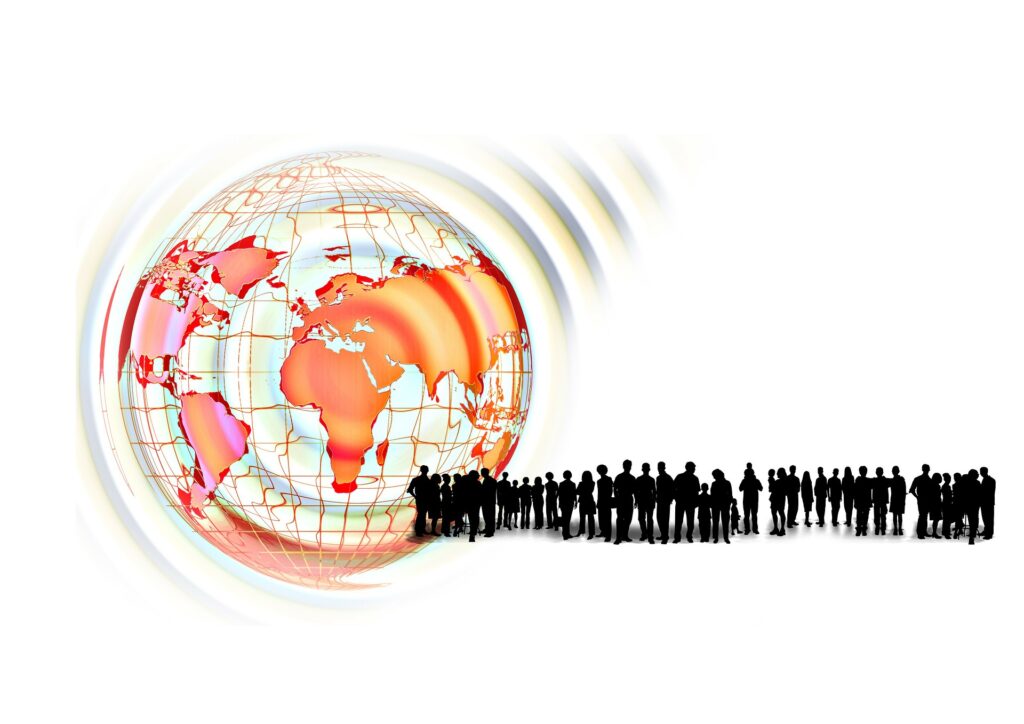
Sound and music is so beautiful and such a rare gem. You can share an experience with someone who is nothing like you, lives in a completely different place, speaks a completely different language, thinks differently and looks differently. Even with all of these factors at play, you can still share in and bond over something you have in common; sound.
Sound connects us. Sound shapes us. Sound is everywhere and in everything. Even the deaf who can’t audibly hear sound can feel it.
Sound is powerful. So let’s utilize that power and tell our story through a medium that has not yet been fully realized.
Let’s experiment. Now’s the time to play with this concept. Look around you. Listen…really listen. What does your world sound like? And when you discover what it sounds like, share it. I guarantee that someone will be listening.
[{"id":5953,"link":"https:\/\/www.dreamrproductions.com\/sound-strategy-for-brands-works\/","name":"sound-strategy-for-brands-works","thumbnail":{"url":"https:\/\/www.dreamrproductions.com\/wp-content\/uploads\/Cover-Photo-Why-Brands-Need-Sound-Strategy-scaled.jpg","alt":"silhouetted women holding large megaphone"},"title":"Sound Strategy For Brands Works","author":{"name":"Dreamr Productions","link":"https:\/\/www.dreamrproductions.com\/author\/jeanna\/"},"date":"Jan 16, 2025","dateGMT":"2025-01-16 23:49:43","modifiedDate":"2025-01-16 15:50:55","modifiedDateGMT":"2025-01-16 23:50:55","commentCount":"1","commentStatus":"open","categories":{"coma":"<a href=\"https:\/\/www.dreamrproductions.com\/category\/blog\/\" rel=\"category tag\">Blog<\/a>, <a href=\"https:\/\/www.dreamrproductions.com\/category\/blog\/sonic-branding-articles\/\" rel=\"category tag\">Sonic Branding<\/a>, <a href=\"https:\/\/www.dreamrproductions.com\/category\/blog\/sound-in-marketing-articles\/\" rel=\"category tag\">Sound In Marketing<\/a>","space":"<a href=\"https:\/\/www.dreamrproductions.com\/category\/blog\/\" rel=\"category tag\">Blog<\/a> <a href=\"https:\/\/www.dreamrproductions.com\/category\/blog\/sonic-branding-articles\/\" rel=\"category tag\">Sonic Branding<\/a> <a href=\"https:\/\/www.dreamrproductions.com\/category\/blog\/sound-in-marketing-articles\/\" rel=\"category tag\">Sound In Marketing<\/a>"},"taxonomies":{"post_tag":"<a href='https:\/\/www.dreamrproductions.com\/tag\/audio-branding\/' rel='post_tag'>audio branding<\/a><a href='https:\/\/www.dreamrproductions.com\/tag\/dreamer-productions\/' rel='post_tag'>dreamer productions<\/a><a href='https:\/\/www.dreamrproductions.com\/tag\/dreamr-productions\/' rel='post_tag'>dreamr productions<\/a><a href='https:\/\/www.dreamrproductions.com\/tag\/jeana-isham\/' rel='post_tag'>jeana isham<\/a><a href='https:\/\/www.dreamrproductions.com\/tag\/jeanna-isham\/' rel='post_tag'>Jeanna Isham<\/a><a href='https:\/\/www.dreamrproductions.com\/tag\/sensory-marketing\/' rel='post_tag'>sensory marketing<\/a><a href='https:\/\/www.dreamrproductions.com\/tag\/sonic-branding\/' rel='post_tag'>sonic branding<\/a><a href='https:\/\/www.dreamrproductions.com\/tag\/sound-in-marketing\/' rel='post_tag'>sound in marketing<\/a><a href='https:\/\/www.dreamrproductions.com\/tag\/sound-marketing\/' rel='post_tag'>sound marketing<\/a><a href='https:\/\/www.dreamrproductions.com\/tag\/sound-strategy\/' rel='post_tag'>sound strategy<\/a>"},"readTime":{"min":4,"sec":46},"status":"publish","excerpt":"All brands make sound. It's important to make sound on purpose. Sound strategy and sonic branding is the future of brand marketing."},{"id":5889,"link":"https:\/\/www.dreamrproductions.com\/what-if-vegas-had-a-sound-strategy\/","name":"what-if-vegas-had-a-sound-strategy","thumbnail":{"url":"https:\/\/www.dreamrproductions.com\/wp-content\/uploads\/kvnga-vBWsG91aR_U-unsplash-resize.jpg","alt":"casino slot machines all making a cacophony of sound"},"title":"Vegas' Winning Hand; Sound Strategy Changing Sin City For The Best","author":{"name":"Dreamr Productions","link":"https:\/\/www.dreamrproductions.com\/author\/jeanna\/"},"date":"Apr 25, 2024","dateGMT":"2024-04-25 21:26:47","modifiedDate":"2025-01-16 15:09:47","modifiedDateGMT":"2025-01-16 23:09:47","commentCount":"0","commentStatus":"open","categories":{"coma":"<a href=\"https:\/\/www.dreamrproductions.com\/category\/blog\/\" rel=\"category tag\">Blog<\/a>, <a href=\"https:\/\/www.dreamrproductions.com\/category\/blog\/sonic-branding-articles\/\" rel=\"category tag\">Sonic Branding<\/a>, <a href=\"https:\/\/www.dreamrproductions.com\/category\/blog\/sound-in-marketing-articles\/\" rel=\"category tag\">Sound In Marketing<\/a>","space":"<a href=\"https:\/\/www.dreamrproductions.com\/category\/blog\/\" rel=\"category tag\">Blog<\/a> <a href=\"https:\/\/www.dreamrproductions.com\/category\/blog\/sonic-branding-articles\/\" rel=\"category tag\">Sonic Branding<\/a> <a href=\"https:\/\/www.dreamrproductions.com\/category\/blog\/sound-in-marketing-articles\/\" rel=\"category tag\">Sound In Marketing<\/a>"},"taxonomies":{"post_tag":"<a href='https:\/\/www.dreamrproductions.com\/tag\/gambling\/' rel='post_tag'>gambling<\/a><a href='https:\/\/www.dreamrproductions.com\/tag\/las-vegas\/' rel='post_tag'>las vegas<\/a><a href='https:\/\/www.dreamrproductions.com\/tag\/slot-machines\/' rel='post_tag'>slot machines<\/a><a href='https:\/\/www.dreamrproductions.com\/tag\/vegas\/' rel='post_tag'>vegas<\/a>"},"readTime":{"min":7,"sec":49},"status":"publish","excerpt":"Could Vegas be even more successful with a sound strategy for individual casinos, hotels, game category in mind? Could they go from disorienting to inviting?"},{"id":5808,"link":"https:\/\/www.dreamrproductions.com\/left-coast-airlines-fake-case-study\/","name":"left-coast-airlines-fake-case-study","thumbnail":{"url":"https:\/\/www.dreamrproductions.com\/wp-content\/uploads\/Left-Coast-Airlines-Logo-scaled.jpg","alt":"Left Coast Airlines Logo"},"title":"Left Coast Airlines; A Sonic Branding Case Study","author":{"name":"Dreamr Productions","link":"https:\/\/www.dreamrproductions.com\/author\/jeanna\/"},"date":"Feb 5, 2024","dateGMT":"2024-02-05 20:24:47","modifiedDate":"2025-03-11 13:41:54","modifiedDateGMT":"2025-03-11 21:41:54","commentCount":"0","commentStatus":"open","categories":{"coma":"<a href=\"https:\/\/www.dreamrproductions.com\/category\/blog\/sound-in-marketing-articles\/\" rel=\"category tag\">Sound In Marketing<\/a>","space":"<a href=\"https:\/\/www.dreamrproductions.com\/category\/blog\/sound-in-marketing-articles\/\" rel=\"category tag\">Sound In Marketing<\/a>"},"taxonomies":{"post_tag":"<a href='https:\/\/www.dreamrproductions.com\/tag\/dreamer-productions\/' rel='post_tag'>dreamer productions<\/a><a href='https:\/\/www.dreamrproductions.com\/tag\/dreamr-productions\/' rel='post_tag'>dreamr productions<\/a><a href='https:\/\/www.dreamrproductions.com\/tag\/jeana-isham\/' rel='post_tag'>jeana isham<\/a><a href='https:\/\/www.dreamrproductions.com\/tag\/jeanna-isham\/' rel='post_tag'>Jeanna Isham<\/a><a href='https:\/\/www.dreamrproductions.com\/tag\/pepsico\/' rel='post_tag'>pepsico.<\/a><a href='https:\/\/www.dreamrproductions.com\/tag\/sensory-marketing\/' rel='post_tag'>sensory marketing<\/a><a href='https:\/\/www.dreamrproductions.com\/tag\/sonic-branding\/' rel='post_tag'>sonic branding<\/a><a href='https:\/\/www.dreamrproductions.com\/tag\/sound-in-marketing\/' rel='post_tag'>sound in marketing<\/a><a href='https:\/\/www.dreamrproductions.com\/tag\/sound-marketing\/' rel='post_tag'>sound marketing<\/a><a href='https:\/\/www.dreamrproductions.com\/tag\/sunchips\/' rel='post_tag'>sunchips<\/a>"},"readTime":{"min":6,"sec":23},"status":"publish","excerpt":"Left Coast Airlines hired Dreamr Productions to produce a branded podcast that advertised to both new and existing customers."},{"id":5780,"link":"https:\/\/www.dreamrproductions.com\/sun-chips-revenue-dropped-over-a-bag-design-blunder\/","name":"sun-chips-revenue-dropped-over-a-bag-design-blunder","thumbnail":{"url":"https:\/\/www.dreamrproductions.com\/wp-content\/uploads\/shutterstock_2270365737-sunchips-bags-resized-scaled.jpg","alt":"SunChips bags on shelf"},"title":"Sun Chips\u2019 Revenue Dropped 11% Over A Bag Design Blunder","author":{"name":"Dreamr Productions","link":"https:\/\/www.dreamrproductions.com\/author\/jeanna\/"},"date":"Jan 16, 2024","dateGMT":"2024-01-16 12:36:00","modifiedDate":"2024-01-15 16:36:45","modifiedDateGMT":"2024-01-16 00:36:45","commentCount":"0","commentStatus":"open","categories":{"coma":"<a href=\"https:\/\/www.dreamrproductions.com\/category\/blog\/sensory-marketing-articles\/\" rel=\"category tag\">Sensory Marketing<\/a>, <a href=\"https:\/\/www.dreamrproductions.com\/category\/blog\/sound-in-marketing-articles\/\" rel=\"category tag\">Sound In Marketing<\/a>","space":"<a href=\"https:\/\/www.dreamrproductions.com\/category\/blog\/sensory-marketing-articles\/\" rel=\"category tag\">Sensory Marketing<\/a> <a href=\"https:\/\/www.dreamrproductions.com\/category\/blog\/sound-in-marketing-articles\/\" rel=\"category tag\">Sound In Marketing<\/a>"},"taxonomies":{"post_tag":"<a href='https:\/\/www.dreamrproductions.com\/tag\/dreamer-productions\/' rel='post_tag'>dreamer productions<\/a><a href='https:\/\/www.dreamrproductions.com\/tag\/dreamr-productions\/' rel='post_tag'>dreamr productions<\/a><a href='https:\/\/www.dreamrproductions.com\/tag\/jeana-isham\/' rel='post_tag'>jeana isham<\/a><a href='https:\/\/www.dreamrproductions.com\/tag\/jeanna-isham\/' rel='post_tag'>Jeanna Isham<\/a><a href='https:\/\/www.dreamrproductions.com\/tag\/pepsico\/' rel='post_tag'>pepsico.<\/a><a href='https:\/\/www.dreamrproductions.com\/tag\/sensory-marketing\/' rel='post_tag'>sensory marketing<\/a><a href='https:\/\/www.dreamrproductions.com\/tag\/sonic-branding\/' rel='post_tag'>sonic branding<\/a><a href='https:\/\/www.dreamrproductions.com\/tag\/sound-in-marketing\/' rel='post_tag'>sound in marketing<\/a><a href='https:\/\/www.dreamrproductions.com\/tag\/sound-marketing\/' rel='post_tag'>sound marketing<\/a><a href='https:\/\/www.dreamrproductions.com\/tag\/sunchips\/' rel='post_tag'>sunchips<\/a>"},"readTime":{"min":5,"sec":45},"status":"publish","excerpt":"No sound is too small. Take the sound of the 2010 Sun Chips biodegradable bag. Too much sound created major problems with the brands' bottom line."},{"id":5778,"link":"https:\/\/www.dreamrproductions.com\/tiktok-ocean-spray-fleetwood-mac\/","name":"tiktok-ocean-spray-fleetwood-mac","thumbnail":{"url":"https:\/\/www.dreamrproductions.com\/wp-content\/uploads\/jeremy-bishop-_CFv3bntQlQ-unsplash-scaled.jpg","alt":"surfer riding a big wave"},"title":"TikTok, Ocean Spray, and Fleetwood Mac Get It- Do You?","author":{"name":"Dreamr Productions","link":"https:\/\/www.dreamrproductions.com\/author\/jeanna\/"},"date":"Jan 15, 2024","dateGMT":"2024-01-15 21:32:07","modifiedDate":"2024-01-15 13:32:09","modifiedDateGMT":"2024-01-15 21:32:09","commentCount":"0","commentStatus":"open","categories":{"coma":"<a href=\"https:\/\/www.dreamrproductions.com\/category\/blog\/sensory-marketing-articles\/\" rel=\"category tag\">Sensory Marketing<\/a>, <a href=\"https:\/\/www.dreamrproductions.com\/category\/blog\/sound-in-marketing-articles\/\" rel=\"category tag\">Sound In Marketing<\/a>","space":"<a href=\"https:\/\/www.dreamrproductions.com\/category\/blog\/sensory-marketing-articles\/\" rel=\"category tag\">Sensory Marketing<\/a> <a href=\"https:\/\/www.dreamrproductions.com\/category\/blog\/sound-in-marketing-articles\/\" rel=\"category tag\">Sound In Marketing<\/a>"},"taxonomies":{"post_tag":"<a href='https:\/\/www.dreamrproductions.com\/tag\/dreamer-productions\/' rel='post_tag'>dreamer productions<\/a><a href='https:\/\/www.dreamrproductions.com\/tag\/dreamr-productions\/' rel='post_tag'>dreamr productions<\/a><a href='https:\/\/www.dreamrproductions.com\/tag\/jeana-isham\/' rel='post_tag'>jeana isham<\/a><a href='https:\/\/www.dreamrproductions.com\/tag\/jeanna-isham\/' rel='post_tag'>Jeanna Isham<\/a><a href='https:\/\/www.dreamrproductions.com\/tag\/ocean-spray\/' rel='post_tag'>ocean spray<\/a><a href='https:\/\/www.dreamrproductions.com\/tag\/sensory-marketing\/' rel='post_tag'>sensory marketing<\/a><a href='https:\/\/www.dreamrproductions.com\/tag\/sonic-branding\/' rel='post_tag'>sonic branding<\/a><a href='https:\/\/www.dreamrproductions.com\/tag\/sound-in-marketing\/' rel='post_tag'>sound in marketing<\/a><a href='https:\/\/www.dreamrproductions.com\/tag\/sound-marketing\/' rel='post_tag'>sound marketing<\/a><a href='https:\/\/www.dreamrproductions.com\/tag\/tiktok\/' rel='post_tag'>tiktok<\/a>"},"readTime":{"min":4,"sec":19},"status":"publish","excerpt":"What does Nathan do when his TikTok goes viral for him, Ocean Spray, and Fleetwood Mac? They all just ride the wave."},{"id":5779,"link":"https:\/\/www.dreamrproductions.com\/powerful-sounds-of-a-cassette-tape\/","name":"powerful-sounds-of-a-cassette-tape","thumbnail":{"url":"https:\/\/www.dreamrproductions.com\/wp-content\/uploads\/shutupanddance-scaled.jpg","alt":"Paula Abdul cassette"},"title":"Powerful Sounds of A Cassette Tape and Other Sounds To Cherish","author":{"name":"Dreamr Productions","link":"https:\/\/www.dreamrproductions.com\/author\/jeanna\/"},"date":"Jan 11, 2024","dateGMT":"2024-01-11 23:54:12","modifiedDate":"2024-01-11 16:05:23","modifiedDateGMT":"2024-01-12 00:05:23","commentCount":"0","commentStatus":"open","categories":{"coma":"<a href=\"https:\/\/www.dreamrproductions.com\/category\/blog\/sensory-marketing-articles\/\" rel=\"category tag\">Sensory Marketing<\/a>, <a href=\"https:\/\/www.dreamrproductions.com\/category\/blog\/sound-in-marketing-articles\/\" rel=\"category tag\">Sound In Marketing<\/a>","space":"<a href=\"https:\/\/www.dreamrproductions.com\/category\/blog\/sensory-marketing-articles\/\" rel=\"category tag\">Sensory Marketing<\/a> <a href=\"https:\/\/www.dreamrproductions.com\/category\/blog\/sound-in-marketing-articles\/\" rel=\"category tag\">Sound In Marketing<\/a>"},"taxonomies":{"post_tag":"<a href='https:\/\/www.dreamrproductions.com\/tag\/dreamer-productions\/' rel='post_tag'>dreamer productions<\/a><a href='https:\/\/www.dreamrproductions.com\/tag\/dreamr-productions\/' rel='post_tag'>dreamr productions<\/a><a href='https:\/\/www.dreamrproductions.com\/tag\/jeana-isham\/' rel='post_tag'>jeana isham<\/a><a href='https:\/\/www.dreamrproductions.com\/tag\/jeanna-isham\/' rel='post_tag'>Jeanna Isham<\/a><a href='https:\/\/www.dreamrproductions.com\/tag\/sensory-marketing\/' rel='post_tag'>sensory marketing<\/a><a href='https:\/\/www.dreamrproductions.com\/tag\/sonic-branding\/' rel='post_tag'>sonic branding<\/a><a href='https:\/\/www.dreamrproductions.com\/tag\/sound-in-marketing\/' rel='post_tag'>sound in marketing<\/a><a href='https:\/\/www.dreamrproductions.com\/tag\/sound-marketing\/' rel='post_tag'>sound marketing<\/a>"},"readTime":{"min":5,"sec":45},"status":"publish","excerpt":"The sounds of a cassette tape were arguably more powerful and reminiscent than the music they actually played."},{"id":5697,"link":"https:\/\/www.dreamrproductions.com\/transformational-power-of-sonic-branding-stimulates-marketing-pitch\/","name":"transformational-power-of-sonic-branding-stimulates-marketing-pitch","thumbnail":{"url":"https:\/\/www.dreamrproductions.com\/wp-content\/uploads\/greg-rakozy-oMpAz-DN-9I-unsplash-scaled.jpg","alt":"man staring up at the stars at night"},"title":"The Transformational Power of Sonic Branding That Can Stimulate Your Marketing Pitch In Seconds","author":{"name":"Dreamr Productions","link":"https:\/\/www.dreamrproductions.com\/author\/jeanna\/"},"date":"Nov 10, 2023","dateGMT":"2023-11-10 16:42:02","modifiedDate":"2023-10-26 08:42:58","modifiedDateGMT":"2023-10-26 16:42:58","commentCount":"0","commentStatus":"open","categories":{"coma":"<a href=\"https:\/\/www.dreamrproductions.com\/category\/blog\/sensory-marketing-articles\/\" rel=\"category tag\">Sensory Marketing<\/a>, <a href=\"https:\/\/www.dreamrproductions.com\/category\/blog\/sonic-branding-articles\/\" rel=\"category tag\">Sonic Branding<\/a>, <a href=\"https:\/\/www.dreamrproductions.com\/category\/blog\/sound-in-marketing-articles\/\" rel=\"category tag\">Sound In Marketing<\/a>","space":"<a href=\"https:\/\/www.dreamrproductions.com\/category\/blog\/sensory-marketing-articles\/\" rel=\"category tag\">Sensory Marketing<\/a> <a href=\"https:\/\/www.dreamrproductions.com\/category\/blog\/sonic-branding-articles\/\" rel=\"category tag\">Sonic Branding<\/a> <a href=\"https:\/\/www.dreamrproductions.com\/category\/blog\/sound-in-marketing-articles\/\" rel=\"category tag\">Sound In Marketing<\/a>"},"taxonomies":{"post_tag":"<a href='https:\/\/www.dreamrproductions.com\/tag\/dreamer-productions\/' rel='post_tag'>dreamer productions<\/a><a href='https:\/\/www.dreamrproductions.com\/tag\/dreamr-productions\/' rel='post_tag'>dreamr productions<\/a><a href='https:\/\/www.dreamrproductions.com\/tag\/jeana-isham\/' rel='post_tag'>jeana isham<\/a><a href='https:\/\/www.dreamrproductions.com\/tag\/jeanna-isham\/' rel='post_tag'>Jeanna Isham<\/a><a href='https:\/\/www.dreamrproductions.com\/tag\/sensory-marketing\/' rel='post_tag'>sensory marketing<\/a><a href='https:\/\/www.dreamrproductions.com\/tag\/sonic-branding\/' rel='post_tag'>sonic branding<\/a><a href='https:\/\/www.dreamrproductions.com\/tag\/sound-in-marketing\/' rel='post_tag'>sound in marketing<\/a><a href='https:\/\/www.dreamrproductions.com\/tag\/sound-marketing\/' rel='post_tag'>sound marketing<\/a>"},"readTime":{"min":3,"sec":57},"status":"publish","excerpt":"Sonic branding is the extra bit of branding power that can send your brand identity into the stratosphere of notoriety and recollection."},{"id":5698,"link":"https:\/\/www.dreamrproductions.com\/sound-strategy-for-pharmaceutical-sales-holds-huge-opportunity-for-medicine\/","name":"sound-strategy-for-pharmaceutical-sales-holds-huge-opportunity-for-medicine","thumbnail":{"url":"https:\/\/www.dreamrproductions.com\/wp-content\/uploads\/hal-gatewood-iPl3q-gEGzY-unsplash-scaled.jpg","alt":"white pills against blue background"},"title":"Sound Strategy Transforms the Future of Pharmaceutical Sales","author":{"name":"Dreamr Productions","link":"https:\/\/www.dreamrproductions.com\/author\/jeanna\/"},"date":"Oct 27, 2023","dateGMT":"2023-10-27 16:58:12","modifiedDate":"2023-10-24 09:02:04","modifiedDateGMT":"2023-10-24 17:02:04","commentCount":"0","commentStatus":"open","categories":{"coma":"<a href=\"https:\/\/www.dreamrproductions.com\/category\/blog\/sensory-marketing-articles\/\" rel=\"category tag\">Sensory Marketing<\/a>, <a href=\"https:\/\/www.dreamrproductions.com\/category\/blog\/sonic-branding-articles\/\" rel=\"category tag\">Sonic Branding<\/a>, <a href=\"https:\/\/www.dreamrproductions.com\/category\/blog\/sound-in-marketing-articles\/\" rel=\"category tag\">Sound In Marketing<\/a>","space":"<a href=\"https:\/\/www.dreamrproductions.com\/category\/blog\/sensory-marketing-articles\/\" rel=\"category tag\">Sensory Marketing<\/a> <a href=\"https:\/\/www.dreamrproductions.com\/category\/blog\/sonic-branding-articles\/\" rel=\"category tag\">Sonic Branding<\/a> <a href=\"https:\/\/www.dreamrproductions.com\/category\/blog\/sound-in-marketing-articles\/\" rel=\"category tag\">Sound In Marketing<\/a>"},"taxonomies":{"post_tag":"<a href='https:\/\/www.dreamrproductions.com\/tag\/dreamer-productions\/' rel='post_tag'>dreamer productions<\/a><a href='https:\/\/www.dreamrproductions.com\/tag\/dreamr-productions\/' rel='post_tag'>dreamr productions<\/a><a href='https:\/\/www.dreamrproductions.com\/tag\/jeana-isham\/' rel='post_tag'>jeana isham<\/a><a href='https:\/\/www.dreamrproductions.com\/tag\/jeanna-isham\/' rel='post_tag'>Jeanna Isham<\/a><a href='https:\/\/www.dreamrproductions.com\/tag\/sensory-marketing\/' rel='post_tag'>sensory marketing<\/a><a href='https:\/\/www.dreamrproductions.com\/tag\/sonic-branding\/' rel='post_tag'>sonic branding<\/a><a href='https:\/\/www.dreamrproductions.com\/tag\/sound-in-marketing\/' rel='post_tag'>sound in marketing<\/a><a href='https:\/\/www.dreamrproductions.com\/tag\/sound-marketing\/' rel='post_tag'>sound marketing<\/a>"},"readTime":{"min":4,"sec":54},"status":"publish","excerpt":"Some pharmaceutical sales companies have found a way to stand out in a crowd by utilizing their branded sound with an actual marketing strategy."},{"id":5696,"link":"https:\/\/www.dreamrproductions.com\/sonic-branding-creates-action-in-marketing\/","name":"sonic-branding-creates-action-in-marketing","thumbnail":{"url":"https:\/\/www.dreamrproductions.com\/wp-content\/uploads\/mick-haupt-WXnBzI7AypY-unsplash-scaled.jpg","alt":"buying supplies and loading into car"},"title":"Sound and Sonic Branding Creates Action in Marketing","author":{"name":"Dreamr Productions","link":"https:\/\/www.dreamrproductions.com\/author\/jeanna\/"},"date":"Oct 23, 2023","dateGMT":"2023-10-23 15:33:06","modifiedDate":"2023-10-23 07:33:09","modifiedDateGMT":"2023-10-23 15:33:09","commentCount":"0","commentStatus":"open","categories":{"coma":"<a href=\"https:\/\/www.dreamrproductions.com\/category\/blog\/sensory-marketing-articles\/\" rel=\"category tag\">Sensory Marketing<\/a>, <a href=\"https:\/\/www.dreamrproductions.com\/category\/blog\/sonic-branding-articles\/\" rel=\"category tag\">Sonic Branding<\/a>, <a href=\"https:\/\/www.dreamrproductions.com\/category\/blog\/sound-in-marketing-articles\/\" rel=\"category tag\">Sound In Marketing<\/a>","space":"<a href=\"https:\/\/www.dreamrproductions.com\/category\/blog\/sensory-marketing-articles\/\" rel=\"category tag\">Sensory Marketing<\/a> <a href=\"https:\/\/www.dreamrproductions.com\/category\/blog\/sonic-branding-articles\/\" rel=\"category tag\">Sonic Branding<\/a> <a href=\"https:\/\/www.dreamrproductions.com\/category\/blog\/sound-in-marketing-articles\/\" rel=\"category tag\">Sound In Marketing<\/a>"},"taxonomies":{"post_tag":"<a href='https:\/\/www.dreamrproductions.com\/tag\/dreamer-productions\/' rel='post_tag'>dreamer productions<\/a><a href='https:\/\/www.dreamrproductions.com\/tag\/dreamr-productions\/' rel='post_tag'>dreamr productions<\/a><a href='https:\/\/www.dreamrproductions.com\/tag\/jeana-isham\/' rel='post_tag'>jeana isham<\/a><a href='https:\/\/www.dreamrproductions.com\/tag\/jeanna-isham\/' rel='post_tag'>Jeanna Isham<\/a><a href='https:\/\/www.dreamrproductions.com\/tag\/sensory-marketing\/' rel='post_tag'>sensory marketing<\/a><a href='https:\/\/www.dreamrproductions.com\/tag\/sonic-branding\/' rel='post_tag'>sonic branding<\/a><a href='https:\/\/www.dreamrproductions.com\/tag\/sound-in-marketing\/' rel='post_tag'>sound in marketing<\/a><a href='https:\/\/www.dreamrproductions.com\/tag\/sound-marketing\/' rel='post_tag'>sound marketing<\/a>"},"readTime":{"min":4,"sec":5},"status":"publish","excerpt":"Emotion is a super power that creates sales, word of mouth marketing, and loyal brand advocacy. Consider using sound in marketing to create longterm ROI for your brand."},{"id":5641,"link":"https:\/\/www.dreamrproductions.com\/sonic-branding-sound-made-on-purpose\/","name":"sonic-branding-sound-made-on-purpose","thumbnail":{"url":"https:\/\/www.dreamrproductions.com\/wp-content\/uploads\/elice-moore-E-AUpYXbjM-unsplash-scaled.jpg","alt":"upside down girl listening to headphones"},"title":"Sonic Branding is Sound Made On Purpose","author":{"name":"Dreamr Productions","link":"https:\/\/www.dreamrproductions.com\/author\/jeanna\/"},"date":"Oct 5, 2023","dateGMT":"2023-10-05 19:00:56","modifiedDate":"2023-10-05 11:00:58","modifiedDateGMT":"2023-10-05 19:00:58","commentCount":"0","commentStatus":"open","categories":{"coma":"<a href=\"https:\/\/www.dreamrproductions.com\/category\/blog\/sensory-marketing-articles\/\" rel=\"category tag\">Sensory Marketing<\/a>, <a href=\"https:\/\/www.dreamrproductions.com\/category\/blog\/sonic-branding-articles\/\" rel=\"category tag\">Sonic Branding<\/a>, <a href=\"https:\/\/www.dreamrproductions.com\/category\/blog\/sound-in-marketing-articles\/\" rel=\"category tag\">Sound In Marketing<\/a>","space":"<a href=\"https:\/\/www.dreamrproductions.com\/category\/blog\/sensory-marketing-articles\/\" rel=\"category tag\">Sensory Marketing<\/a> <a href=\"https:\/\/www.dreamrproductions.com\/category\/blog\/sonic-branding-articles\/\" rel=\"category tag\">Sonic Branding<\/a> <a href=\"https:\/\/www.dreamrproductions.com\/category\/blog\/sound-in-marketing-articles\/\" rel=\"category tag\">Sound In Marketing<\/a>"},"taxonomies":{"post_tag":"<a href='https:\/\/www.dreamrproductions.com\/tag\/dreamer-productions\/' rel='post_tag'>dreamer productions<\/a><a href='https:\/\/www.dreamrproductions.com\/tag\/dreamr-productions\/' rel='post_tag'>dreamr productions<\/a><a href='https:\/\/www.dreamrproductions.com\/tag\/jeana-isham\/' rel='post_tag'>jeana isham<\/a><a href='https:\/\/www.dreamrproductions.com\/tag\/jeanna-isham\/' rel='post_tag'>Jeanna Isham<\/a><a href='https:\/\/www.dreamrproductions.com\/tag\/sensory-marketing\/' rel='post_tag'>sensory marketing<\/a><a href='https:\/\/www.dreamrproductions.com\/tag\/sonic-branding\/' rel='post_tag'>sonic branding<\/a><a href='https:\/\/www.dreamrproductions.com\/tag\/sound-in-marketing\/' rel='post_tag'>sound in marketing<\/a><a href='https:\/\/www.dreamrproductions.com\/tag\/sound-marketing\/' rel='post_tag'>sound marketing<\/a>"},"readTime":{"min":6,"sec":59},"status":"publish","excerpt":"Through the art of sonic branding and sound in marketing, brands are able to strengthen their awareness, connection, and conversion with their consumers by making sound on purpose."},{"id":5640,"link":"https:\/\/www.dreamrproductions.com\/small-business-secret-sauce-ring-the-register-with-sound-branding\/","name":"small-business-secret-sauce-ring-the-register-with-sound-branding","thumbnail":{"url":"https:\/\/www.dreamrproductions.com\/wp-content\/uploads\/kristina-flour-BcjdbyKWquw-unsplash-scaled.jpg","alt":"hush"},"title":"Sound Branding is Small Businesses' Secret Sauce","author":{"name":"Dreamr Productions","link":"https:\/\/www.dreamrproductions.com\/author\/jeanna\/"},"date":"Oct 3, 2023","dateGMT":"2023-10-03 20:41:11","modifiedDate":"2023-10-03 12:41:14","modifiedDateGMT":"2023-10-03 20:41:14","commentCount":"0","commentStatus":"open","categories":{"coma":"<a href=\"https:\/\/www.dreamrproductions.com\/category\/blog\/sensory-marketing-articles\/\" rel=\"category tag\">Sensory Marketing<\/a>, <a href=\"https:\/\/www.dreamrproductions.com\/category\/blog\/sonic-branding-articles\/\" rel=\"category tag\">Sonic Branding<\/a>, <a href=\"https:\/\/www.dreamrproductions.com\/category\/blog\/sound-in-marketing-articles\/\" rel=\"category tag\">Sound In Marketing<\/a>","space":"<a href=\"https:\/\/www.dreamrproductions.com\/category\/blog\/sensory-marketing-articles\/\" rel=\"category tag\">Sensory Marketing<\/a> <a href=\"https:\/\/www.dreamrproductions.com\/category\/blog\/sonic-branding-articles\/\" rel=\"category tag\">Sonic Branding<\/a> <a href=\"https:\/\/www.dreamrproductions.com\/category\/blog\/sound-in-marketing-articles\/\" rel=\"category tag\">Sound In Marketing<\/a>"},"taxonomies":{"post_tag":"<a href='https:\/\/www.dreamrproductions.com\/tag\/dreamer-productions\/' rel='post_tag'>dreamer productions<\/a><a href='https:\/\/www.dreamrproductions.com\/tag\/dreamr-productions\/' rel='post_tag'>dreamr productions<\/a><a href='https:\/\/www.dreamrproductions.com\/tag\/jeana-isham\/' rel='post_tag'>jeana isham<\/a><a href='https:\/\/www.dreamrproductions.com\/tag\/jeanna-isham\/' rel='post_tag'>Jeanna Isham<\/a><a href='https:\/\/www.dreamrproductions.com\/tag\/sensory-marketing\/' rel='post_tag'>sensory marketing<\/a><a href='https:\/\/www.dreamrproductions.com\/tag\/sonic-branding\/' rel='post_tag'>sonic branding<\/a><a href='https:\/\/www.dreamrproductions.com\/tag\/sound-in-marketing\/' rel='post_tag'>sound in marketing<\/a><a href='https:\/\/www.dreamrproductions.com\/tag\/sound-marketing\/' rel='post_tag'>sound marketing<\/a>"},"readTime":{"min":3,"sec":53},"status":"publish","excerpt":"Small business has the opportunity to market through sound branding. With purposeful strategy, there is a huge opportunity for big returns."},{"id":5642,"link":"https:\/\/www.dreamrproductions.com\/sonic-branding-for-small-business-future-marketing\/","name":"sonic-branding-for-small-business-future-marketing","thumbnail":{"url":"https:\/\/www.dreamrproductions.com\/wp-content\/uploads\/goldengoose.png","alt":"music in marketing is the golden goose"},"title":"Sonic Branding For Small Business; The Golden Goose of Future Marketing","author":{"name":"Dreamr Productions","link":"https:\/\/www.dreamrproductions.com\/author\/jeanna\/"},"date":"Sep 23, 2023","dateGMT":"2023-09-23 14:08:11","modifiedDate":"2023-09-23 06:08:13","modifiedDateGMT":"2023-09-23 14:08:13","commentCount":"0","commentStatus":"open","categories":{"coma":"<a href=\"https:\/\/www.dreamrproductions.com\/category\/blog\/sensory-marketing-articles\/\" rel=\"category tag\">Sensory Marketing<\/a>, <a href=\"https:\/\/www.dreamrproductions.com\/category\/blog\/sonic-branding-articles\/\" rel=\"category tag\">Sonic Branding<\/a>, <a href=\"https:\/\/www.dreamrproductions.com\/category\/blog\/sound-in-marketing-articles\/\" rel=\"category tag\">Sound In Marketing<\/a>","space":"<a href=\"https:\/\/www.dreamrproductions.com\/category\/blog\/sensory-marketing-articles\/\" rel=\"category tag\">Sensory Marketing<\/a> <a href=\"https:\/\/www.dreamrproductions.com\/category\/blog\/sonic-branding-articles\/\" rel=\"category tag\">Sonic Branding<\/a> <a href=\"https:\/\/www.dreamrproductions.com\/category\/blog\/sound-in-marketing-articles\/\" rel=\"category tag\">Sound In Marketing<\/a>"},"taxonomies":{"post_tag":"<a href='https:\/\/www.dreamrproductions.com\/tag\/dreamer-productions\/' rel='post_tag'>dreamer productions<\/a><a href='https:\/\/www.dreamrproductions.com\/tag\/dreamr-productions\/' rel='post_tag'>dreamr productions<\/a><a href='https:\/\/www.dreamrproductions.com\/tag\/jeana-isham\/' rel='post_tag'>jeana isham<\/a><a href='https:\/\/www.dreamrproductions.com\/tag\/jeanna-isham\/' rel='post_tag'>Jeanna Isham<\/a><a href='https:\/\/www.dreamrproductions.com\/tag\/sensory-marketing\/' rel='post_tag'>sensory marketing<\/a><a href='https:\/\/www.dreamrproductions.com\/tag\/small-business\/' rel='post_tag'>small business<\/a><a href='https:\/\/www.dreamrproductions.com\/tag\/sonic-branding\/' rel='post_tag'>sonic branding<\/a><a href='https:\/\/www.dreamrproductions.com\/tag\/sound-in-marketing\/' rel='post_tag'>sound in marketing<\/a><a href='https:\/\/www.dreamrproductions.com\/tag\/sound-marketing\/' rel='post_tag'>sound marketing<\/a>"},"readTime":{"min":4,"sec":30},"status":"publish","excerpt":"The last thing small business needs is to waste their time and money on something ineffective and un-proven. Sonic branding is the marketing gift that keeps on giving. You can get back to the important job of landing more clients and customers while your sound is working for your brand in the background."}]
